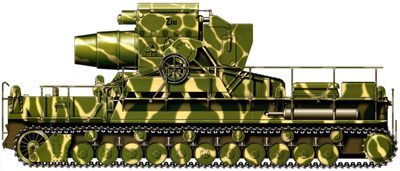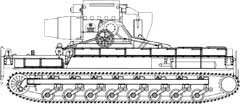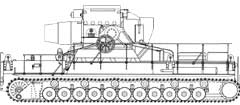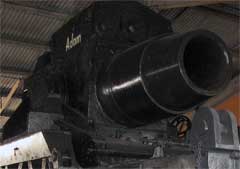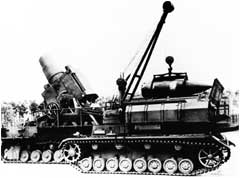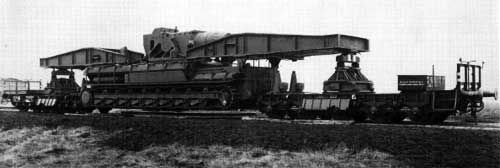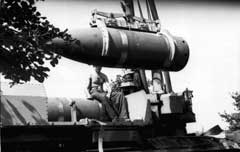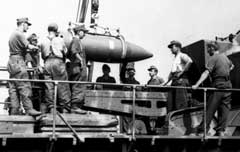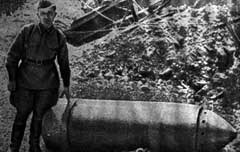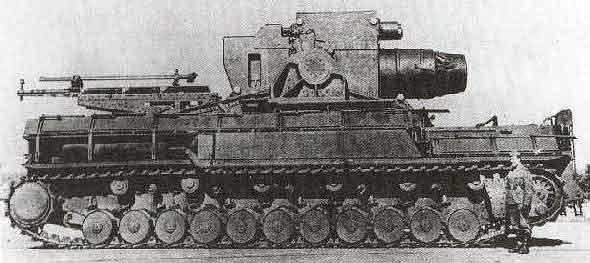
600-mm self-propelled mortar "Karl"
600-mm self-propelled mortar "Karl"Gerät 040, “installation 040”.
The first mortar was made in November 1940, and she received the name "Adam". Until mid-April 1941, three more were released: "Eve", "Thor" and "One". In January 1941, the 833rd heavy artillery battalion (833 Schwere Artillerie Abteilung) was formed, which included two batteries of two guns each. At the beginning of the Great Patriotic War, the 1st battery (“Thor” and “Odin”) was attached to the South Army Group, and the 2nd (“Adam” and “Eve”) to the Center Army Group. The latter shelled the Brest Fortress, while "Adam" fired 16 shots. At “Eva”, the first shot turned out to be protracted, and the entire installation had to be taken to Dusseldorf. The 1st battery was located in the Lvov area. “Thor” fired four shots, “One” did not fire, as it lost its caterpillar. In June 1942, Tor and Odin shelled Sevastopol, firing 172 heavy and 25 light concrete-piercing shells. Their fire suppressed the Soviet 30th coastal battery.
Photo of self-propelled mortars "Karl" (click on the image to enlarge)
At the end of the Second World War, the 600-mm barrels on three mortars - these were “Odin”, “Loki” and “Fernrir” (a reserve installation that did not take part in hostilities) were replaced by 540-mm ones, which provided a firing range of up to 11000 m. Under these barrels, 75 shells weighing 1580 kg were made.
The swinging part of the 600-mm mortar was mounted on a special tracked chassis. For the prototype, the undercarriage consisted of 8 support and 8 support rollers, for serial machines - from 11 support and 6 support. Guidance of the mortar was carried out manually. When fired, the barrel rolled back in the cradle and the entire machine in the machine body. Due to the large magnitude of the recoil force, the self-propelled mortar “Karl” lowered its bottom to the ground before firing, since the undercarriage could not absorb the recoil force of 700 tons.
Ammunition, which consisted of 8 shells, was transported on two armored personnel carriers developed on the basis of the German tank of the Second World War PzKpfw IV Ausf D. Loading was carried out using an arrow mounted on an armored personnel carrier. Each such transporter carried four shells and charges to them. The weight of the projectile was 2200 kg, the firing range reached 6700 m. alternating torque converters. The two-stage planetary slewing mechanism was equipped with a pneumatic servo drive. The torsion bar suspension was connected to a gearbox located in the stern for lowering the machine to the ground. The gearbox was driven by the engine of the machine and, by means of a lever system, turned the ends of the torsion bars opposite to the balancers through a certain angle.
A big problem was the transportation of the 124-ton self-propelled mortar "Karl" to the location of the alleged firing position. When transported by rail, a self-propelled mortar was suspended between two specially equipped platforms (front and rear). On the highway, the car was transported on trailers, disassembled into three parts.
The performance characteristics of the 600-mm self-propelled mortar "Karl"
Sources:
| ||||||||||||||||||||||||||||||||||||||||||||||||||||||||||
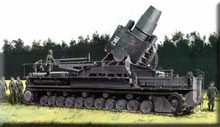 600-mm heavy self-propelled mortars "Karl" - the largest of all self-propelled artillery used in the Second World War. In 1940-1941, 7 vehicles were created (1 prototype and 6 serial self-propelled guns), which were intended for the destruction of long-term defensive structures. The design was carried out by Rheinmetall since 1937. The work was supervised by the head of the Wehrmacht weapons department, General of Artillery
600-mm heavy self-propelled mortars "Karl" - the largest of all self-propelled artillery used in the Second World War. In 1940-1941, 7 vehicles were created (1 prototype and 6 serial self-propelled guns), which were intended for the destruction of long-term defensive structures. The design was carried out by Rheinmetall since 1937. The work was supervised by the head of the Wehrmacht weapons department, General of Artillery 
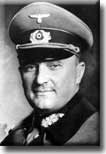 By the end of August 1941, the troops received two more mortars - "Loki" and "Ziu". The latter, as part of the 638th battery, shelled the insurgent Warsaw in August 1944. A mortar intended to bombard Paris was bombed while being transported by rail. The transporter was badly damaged, and the gun was blown up.
By the end of August 1941, the troops received two more mortars - "Loki" and "Ziu". The latter, as part of the 638th battery, shelled the insurgent Warsaw in August 1944. A mortar intended to bombard Paris was bombed while being transported by rail. The transporter was badly damaged, and the gun was blown up.